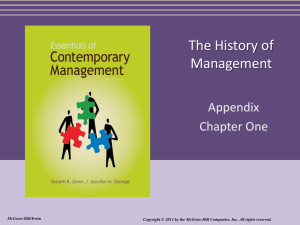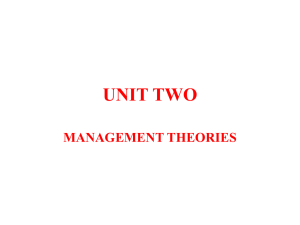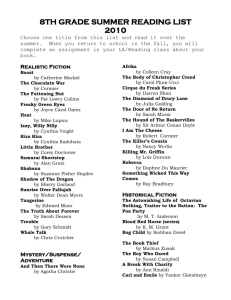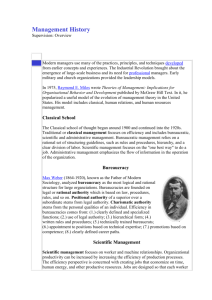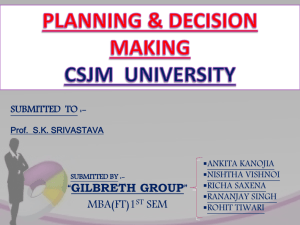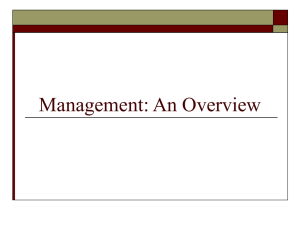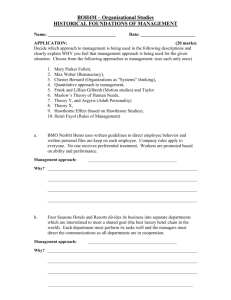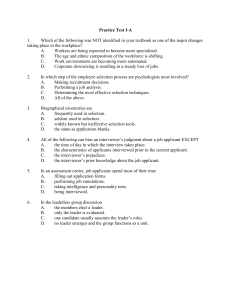3 Frank and Lillian Gilbreth and the Motion Study Controversy, 1907-1930
advertisement
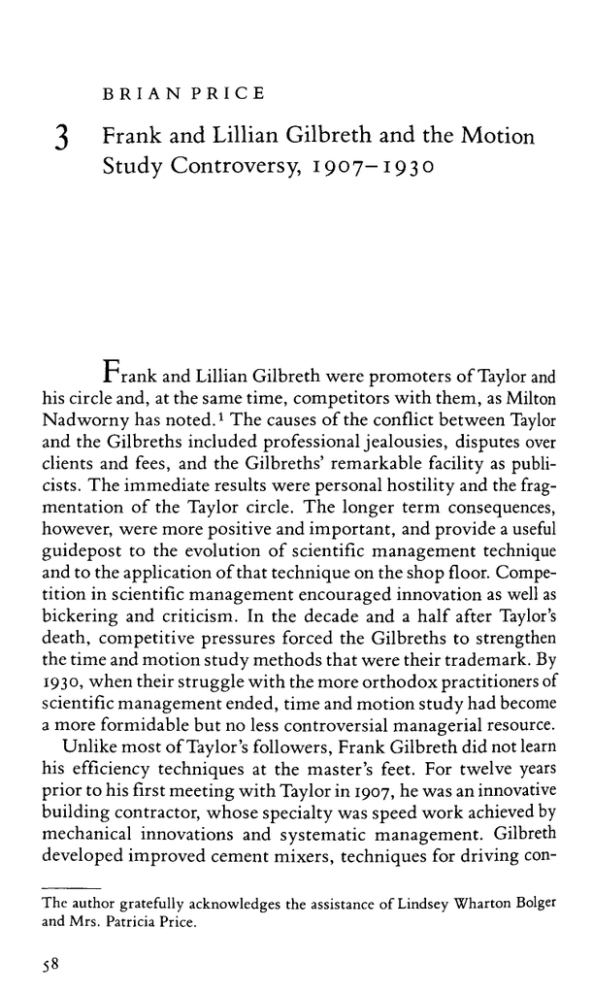
B R I A N 3 PRICE Frank and Lillian Gilbreth and the Motion Study Controversy, 1907-1930 .Prank and Lillian Gilbreth were promoters of Taylor and his circle and, at the same time, competitors with them, as Milton Nadworny has noted.1 The causes of the conflict between Taylor and the Gilbreths included professional jealousies, disputes over clients and fees, and the Gilbreths' remarkable facility as publi­ cists. The immediate results were personal hostility and the frag­ mentation of the Taylor circle. The longer term consequences, however, were more positive and important, and provide a useful guidepost to the evolution of scientific management technique and to the application of that technique on the shop floor. Compe­ tition in scientific management encouraged innovation as well as bickering and criticism. In the decade and a half after Taylor's death, competitive pressures forced the Gilbreths to strengthen the time and motion study methods that were their trademark. By 1930, when their struggle with the more orthodox practitioners of scientific management ended, time and motion study had become a more formidable but no less controversial managerial resource. Unlike most of Taylor's followers, Frank Gilbreth did not learn his efficiency techniques at the master's feet. For twelve years prior to his first meeting with Taylor in 1907, he was an innovative building contractor, whose specialty was speed work achieved by mechanical innovations and systematic management. Gilbreth developed improved cement mixers, techniques for driving conThe author gratefully acknowledges the assistance of Lindsey Wharton Bolger and Mrs. Patricia Price. The Motion Study Controversy • 59 crete foundation piles swiftly, and an adjustable scaffold, which could be raised to keep the masons level with the wall they were building. His Field System, Concrete System, and "Office System" outlined standardized procedures for organizing building sites, facilitating the flow of work on the ground, and enabling manag­ ers to keep the company current on building progress and costs through a series of detailed forms. To increase the worker's efficiency, he organized runways for concrete and brick delivery, advocated competition between gangs of workers (often divided by ethnicity), and designed a "white list" to reward reliable workers with more regular work. 2 Gilbreth did not approach Taylor as a beginner, therefore, but rather as one who had as much to teach as to learn.3 He soon demonstrated his usefulness to the nascent scientific management movement. While employing Stanford Thompson, Taylor's time study expert, to introduce time study for piece rate setting on his building sites, Gilbreth undertook systematic motion study ex­ periments on bricklayers and soon claimed to have reduced their motions from as many as eighteen to as few as four.4 He impressed Taylor, who incorporated Gilbreth's work in The Principles of Scientific Management (1911), and used Gilbreth's bricklaying achievements to illustrate the efficacy of the stopwatch technique he called the "keystone" of scientific management.5 Even at this time, however, occasional differences arose be­ tween the men. The most serious problem occurred when brick­ layers at Gardner, Massachusetts in May, 1908, and at Glen Falls, New York in March, 1911, successfully struck Gilbreth's sites.6 Taylor, feeling that Gilbreth had provoked the Gardner strike by rushing the installation process, ordered Sanford Thompson not to undertake any other work for Gilbreth.7 When Gilbreth faced bankruptcy during the 1911-1912 building industry depression and decided to dedicate himself full time to Taylorism and motion study, he regained some favor with Taylor. Louis Brandeis's promotion of scientific management in the 1910 Eastern Rates Case, and the Watertown Arsenal strike of 1911, raised Taylorism's public profile and galvanized trade union an­ tagonism.8 In defense of his mentor Gilbreth participated in debates against union leaders and organized the Society for the Promotion of the Science of Management (SPSM).9 His wife Lillian, who was completing a Ph.D. in psychology, became his 60 • B R I A N P R I C E active partner at that time. Lillian wrote the Primer of Scientific Management (printed under Frank's name), and Psychology of Man­ agement, both of which argued that Taylorism was the only man­ agement method consistent with the health and development of workers.10 Gilbreth began his scientific management career in 1912 at the New England Butt Company, of Providence, Rhode Island, a firm of 300 employees that produced braiding machines used in the manufacture of shoe laces, dress trimmings, and electrical wire insulation. Gilbreth viewed New England Butt as his version of the Tabor Company of Philadelphia, where Taylor had demon­ strated and promoted scientific management. Indeed, he and Lillian went to Providence to out-Taylor Taylor.11 The history of the Butt Company installation reveals the seri­ ousness with which the Gilbreths took their task. The foundation of the installation was orthodox scientific management: improve­ ments in the routing of work and the organization of tool and store rooms, introduction of a planning department and functional foremen, task setting, and cost accounting. Appropriately, Gil­ breth hired Taylor's disciple, Horace K. Hathaway, to plan and guide these changes.12 In addition, the Gilbreths added two kinds of innovations. First, they responded to the trade unionists' argu­ ment that scientific management was merely a dictatorial driving system by inaugurating industrial betterment programs. They organized a series of weekly meetings of managers, foremen, and workers, during which the progress of the installation was openly debated; a lecture series to allow employees to enhance their knowledge of scientific management and motion study; a sugges­ tion system offering monthly prizes for the best ideas for factory improvement; and a promotion plan that increased upward mo­ bility within the firm.13 Second, Frank Gilbreth developed a new motion study tech­ nique, which he called micromotion study. It involved filming a worker's operations against a cross-sectioned background while a chronometer recorded the time. By examining the film through a magnifying glass, Gilbreth could determine the times of each of the worker's motions to one-thousandth of a second. He could then compare methods and working conditions and synthesize the best elements into a method that would become standard for that job. The Motion Study Controversy • 61 Gilbreth saw micromotion study as a potent antidote to labor hostility, as well as a major advance over stopwatch time study. When the unions charged that time study was a management tool designed to speed up the pace of production, he would show that micromotion study, by replacing the human observer and the stopwatch with the camera and the chronometer, provided scien­ tific accuracy in timing work operations. Furthermore, his films would demonstrate that motion study increased output through more effective use of time rather than through faster speed.14 To forestall the type of problems he had experienced on his building sites at Gardner and Glen Falls, Gilbreth installed his micromotion equipment in a "betterment room" at a remove from the factory floor, paying workers bonuses for allowing him to study them in isolation from their peers.15 Even as the Butt Company installation progressed, Gilbreth sought to publicize micromotion study as an advance over time study and as a benefit to workers. He first summarized his work at the December, 1912 meeting of the American Society of Mechani­ cal Engineers (ASME), claiming that his new technique revolu­ tionized braider machine assembly processes and increased output per assembler from 11-12 to 60 machines per day. The commenta­ tor, Robert T. Kent, called micromotion study "as revolutionary in the art of time study as was the invention of the power loom in the art of weaving."16 In the following months, Gilbreth pressed home his image as an innovator, popularizing his new technique by using it to time the speeds of baseball pitchers and inaugurating a series of Summer Schools of Scientific Management for college professors in Providence, beginning in 1913.17 Taylor was impressed. In his own presentation to the ASME meeting he redefined time study to incorporate Gilbreth's motion study ideas, though not his specific techniques. Dividing time study into "analytical" and "constructive" categories, he argued that time study "analysis" involved dividing a worker's job into its "simple elementary movements," discarding the "useless" ones, timing the quickest and best motions, and making their times the standard for the job. "Constructive" time study involved group­ ing combinations of elementary movements commonly repeated in any trade, and recording and indexing them so that the records could be of use in determining appropriate times in other, parallel kinds of work. Though motion study remained subordinate to 62 • B R I A N P R I C E time study, the attention Taylor paid to it demonstrated the seriousness with which he took the Gilbreths' versions of his "keystone."18 Still, Taylor knew only part of the story. What he did not know, and what Gilbreth did not admit, was that Gilbreth had completed most of his work at the Butt Company by straightforward obser­ vation before the micromotion laboratory had been completed, that the greatly increased output per assembler had been achieved by assigning time-consuming elements of the process to other workers, and that Gilbreth continued to be almost totally reliant on stopwatch time study for piece rate setting because he could not arrange artificial lighting powerful enough to overcome the factory gloom. In short, at the time that Gilbreth announced its virtues, micromotion study had not yet lived up to a single one of them. 19 Moreover industrial betterment had not cured the work­ ers of their misgivings about the Gilbreths. In the late summer of 1912, at a time when trade union militancy against scientific management was at a peak, Frank Gilbreth had narrowly averted a strike at the Butt Company by workers influenced both by the Industrial Workers of the World and the AFL.20 Taylor, wary of Gilbreth's hubris in undertaking a major installation without prior experience, and alarmed by the possibility of another strike, grew increasingly anxious about his work.21 Matters between the two came to a head in 1913-1914, when Gilbreth undertook a major reorganization of the HerrmannAukam Company, a manufacturer of handkerchiefs. To aid him in studying the motions of handkerchief folders, Gilbreth invented additional motion study techniques, which he dubbed cyclegraphs, chronocyclegraphs, and stereochronocyclegraphs. The cyclegraph method involved mounting a miniature electric light on a ring that could be slipped onto a worker's finger, showing on the back of his or her hand. The movement of the light created a bright line on a single time-exposed photograph. A line full of twists and turns bespoke inefficient movement. The worker's tools, equipment, and motions could then be altered until the shortest, smoothest line was developed. Gilbreth improved on the cyclegraph technique by interrupting the flow of current to the light in order to obtain, in the resulting sequence of flashes, a record of the time and direction of the motions. The resulting image was a chronocyclegraph. A stereochronocyclegraph ere­ The Motion Study Controversy • 63 ated a three-dimensional image of motion by using time exposed photographs from two slightly offset cameras, the positives from which could be viewed through a stereopticon or stereoscope. With his customary eye for publicity, Gilbreth arranged for Fred Colvin of the American Machinist to break the news of his latest advances to the engineering world.22 Despite his apparent progress, Gilbreth interrupted his work at Herrmann-Aukam to accept a contract to install scientific man­ agement at the giant Auergesellschaft electric light and gas mantel manufacturing company in Berlin, Germany. In Gilbreth's ab­ sence, the Herrmann-Aukam owners broached Taylor with com­ plaints about the pace and quality of Gilbreth's work. Convinced that Gilbreth was unreliable, Taylor arranged for his orthodox disciple, Hathaway, to finish Gilbreth's job. 2 3 An outraged Gilbreth viewed Taylor's action as a declaration of war. From Germany he wrote Lillian: "We must have our own organization and we must have our own writings so made that the worker thinks we are the good exception (emphasis Gilbreth's)."24 To deal with the negative comments of Taylor and his disciples, Gilbreth immediately decided to keep all information about his present and future installation work secret, sacrificing potential publicity for security against claims of incompetency.25 He also began to rewrite his autobiography. Having earlier emphasized his debt to Taylor, Gilbreth now sought to show that he had invented motion study, independent of, and prior to, his contact with Taylor.26 By the time Frank returned from Germany, Lillian had completed two booklength manuscripts that emphasized both Gilbreth's concern with the "human factor" and his scientific outlook. The first manuscript, published as a series of articles in Iron Age under both of their names, addressed the problem of the trouble­ some "human element." Its primary contention was that motion study was less a series of mechanical devices for improving output than a systematic program for the betterment of the worker. It argued that motion study would train workers and make them valuable aids to management, not mere specialists in a craft or humdrum machine tenders. Such workers could then be individu­ ally rewarded by higher wages and promotion.27 In the second work, Fatigue Study, Lillian Gilbreth argued that the aim of motion study was to eliminate unnecessary fatigue by designing convenient workbenches and chairs, providing regular 64 ' B R I A N P R I C E rest periods, and introducing other salutary measures. This ap­ proach also had strategic and psychological value. By performing a fatigue survey on first entering a factory and providing immedi­ ate antidotes to obvious fatigue-producing activities, such as standing and stretching, the motion study engineer bettered his chances of acceptance by workers more than by announcing that his intention was to speed up production. Together with related activities such as weekly open meetings to discuss fatigue elim­ ination, a suggestion system, and a promotion plan, the motion study engineer added a new dimension to the industrial welfare movement.28 To aid in their effort Gilbreth devised a final motion study innovation. By 1915 he had formulated a basic alphabet of work motions, naming them therbligs ("Gilbreth" reversed, with a small concession to euphony). All work motions, he contended, could be reduced to sixteen categories: search, find, select, grasp, posi­ tion, transport loaded, assemble, use, disassemble, inspect, pre­ position (for next operation), release load, transport empty, wait (unavoidable delay), wait (avoidable delay), and rest (for overcom­ ing fatigue). By analyzing micromotion film or chronocycle­ graphs, the therbligs could be identified and plotted on "simultan­ eous cycle motion" or "simo" charts. The simo chart listed horizontally the parts of the body— arms, legs, trunk, and head— with subdivisions (for example, the upper and lower arm, wrist, thumb, fingers, and palm). The vertical axis displayed elapsed time. By assigning each therblig a color and symbol, Gilbreth could chart each body part's motion over time, producing a clear visualization of the relationships between the therbligs. Simo charts enabled Gilbreth to discern whether, for instance, one arm was actively working while the other was merely passively hold­ ing an object during the motion cycle. If so, he could redesign the operation to employ each arm simultaneously, while shortening the times for movements made by placing tools and parts closer to the worker's grasp. Therbligs provided Gilbreth with a new analytical tool and bolstered his confidence in the validity of his pursuit of a science of motions. Gilbreth nevertheless took the precaution of making his discovery public in a 1915 paper entitled "Motion Study for the Crippled Soldier," whose ostensible sub­ ject, the treatment of handicapped war veterans, reduced the likelihood of a substantial critique. 29 The Motion Study Controversy • 65 To complete their work, the Gilbreths devised a slogan that underlined their concern with the human element and the scien­ tific analysis of work processes. They were, they intoned, devoted to " The quest of the one best way to do work (emphasis Gilbreths'). " 3 0 The Gilbreths' efforts to distinguish themselves from Taylor and his immediate circle had mixed results. Frank organized a Committee for the Elimination of Unnecessary Fatigue within the new Society of Industrial Engineers, hosted regular fatigue lun­ cheons at the Society's quarterly meetings, and worked with the National Safety Council, the American Posture League, and the Eyesight Conservation Committee, stressing motion study's health benefits.31 These activities promoted the Gilbreth name and sug­ gested the breadth of their interests. But their assertion that they were the humane alternative to orthodox scientific management was less persuasive. In the aftermath of World War I, the AFL and the Taylor Society (as the SPSM was renamed) reached a new understanding that ended organized opposition to scientific man­ agement and paved the way for the identification of the Taylor Society with the liberal wing of the business community. Thus, in regard to the "human factor," the perceived distance between the Gilbreths and their opponents rapidly shrank.32 Similarly, their attempt to portray motion study as the central element in a broader management system was unrewarding. While motion study in isolation attracted wide interest, few executives were willing to authorize the more sweeping changes the Gilbreths advocated. This problem elicited two very different responses from the Gilbreths. First, Frank tried to employ motion study as a Trojan horse to gain both entrance to a company and an opportunity to win incremental extensions of his work until he had implementated his entire revisionist system. Second, because the Gilbreths were forced to rely primarily on motion study for income, they felt compelled to defend the scientific efficacy of motion study against the more conservative defenders of stop­ watch time study. Accordingly, they pushed for a decisive show­ down with their critics in an attempt to establish, once and for all, motion study's scientific superiority. A single example of Frank Gilbreth's Trojan horse strategy will suffice. In January, 1919, the Pierce-Arrow automobile company of Buffalo, New York, hired Gilbreth to use motion study to improve assembly procedures for its five-ton truck. Given offices, 66 • B R I A N P R I C E laboratory space for micromotion experiments, and the right to bring in four assistants, Gilbreth initiated changes, not in truck assembly, but in the office system that monitored and directed the assembly procedures. Only later did his assistants begin the systematic examination of carburetor subassembly methods. When they had reduced assembly times from seven and two-tenths hours to one hour under experimental conditions, Gilbreth felt confident in pushing for the extension of his contract to enable him to modernize the company's toolroom, tool sharpening meth­ ods, and storeroom procedures. The company rejected all of these requests except his proposal to revamp its storeroom, and then allowed him to make changes only on a limited, experimental basis. Somewhat disheartened, Gilbreth nevertheless urged the establishment of a messenger service in the drill department, a salvage department to clean up the company yards, and a planning department to coordinate work in the rooms where workers were trained in new assembly methods. The Pierce-Arrow managers turn him down flatly, advising him to keep his nose to the motion study grindstone, eschewing interest in all else. Though this forced concentration soon produced more promising results, the election of a new company president resulted in the revocation of Gilbreth's contract just when he began demonstrations of revised methods for the final assembly of trucks. 33 The Gilbreths' push for a final confrontation with the orthodox scientific managers also produced unexpected results. The Gil­ breths' position on motion study had been clear since 1912: time study was unscientific, fraught with human error, and dependent on obsolete equipment that had been superseded by cinemato­ graphic micromotion study apparatus. Now, thanks to therbligs, the Gilbreths argued additionally that micromotion study could measure objectively the correct elements of worker motions. They elaborated on this position at length in their 1917 book of essays, Applied Motion Study.34 In December 1920, the Gilbreths arranged for a decisive confrontation with their opposition before the Taylor Society. In their presentation, the Gilbreths assailed the validity of stopwatch data, arguing that "the inevitable interference of the human element, when the stop-watch is read while it is running or pressed to stop or start, prevents accurate observations and rec­ ords." 35 Because micromotion study recorded the surrounding The Motion Study Controversy • 67 conditions and behavior of the workers, measured motions in therblig units, and provided absolutely accurate times, it consti­ tutes a "science" that enabled work to be developed, taught, and perpetuated at the highest standard —the "one best way."36 The Taylorites' response was surprisingly restrained. Dwight Merrick admitted that for detailed operations he had often wished for something more accurate than a stopwatch.37 Robert Kent observed that micromotion study devices were less significant than the methods on which they were based.38 Carl Barth con­ tended that micromotion study was good for detailed work, but that, after all, if the magnifying glass was still useful after the invention of microscopes and telescopes, the stopwatch still had a place in scientific management.39 If the Taylorites' response was mild, it was in part because they increasingly endorsed the Gilbreths' approach while ignoring their precise techniques and language.40 Sanford Thompson sum­ marized their position in a preface to a book on time study by his partner, William Lichtner: Our modern engineers, like Mr. Lichtner, realize that the men who work in the mills are not machines, . . . and that the increase in production that we need is one that will benefit, not exploit the workers. Time and job analysis achieves that increased production through saving waste in time and material, by determining the simplest and easiest way. . . . 41 Lichtner's technique consisted of comparing various methods to find the best way of performing the operation under the best conditions, eliminating waste and making allowances for neces­ sary delays and fatigue, and then setting standards and instructing employees in these methods. "The exact and systematic character of time and job analysis," he claimed, "merits for it the term 'sci­ ence.' The 'laws' which it formulates take into consideration the necessary energy . . . to produce with the minimum of machine time and the minimum of human labor the maximum of quantity that is at the same time of the maximum quality. " 42 Substitute "motion study" for "job analysis" and the Gilbreths could not have said it better. Lichtner went on to revise Taylor's statement on the importance of time study to read "job standardization is sometimes called the cornerstone of scientific management."43 68 • B R I A N P R I C E The Gilbreths' attempt to position themselves as the humane and scientific alternative to orthodox scientific management was no more successful abroad than at home. In England, where a government-created Health of Munition Workers Committee (later renamed the Industrial Fatigue Research Board) and a private National Institute of Industrial Psychology used motion study to investigate fatigue and develop improved work methods, the Gilbreths fared badly.44 The prominent psychologist Charles S. Myers, who headed the Institute, and several colleagues published articles arguing that incentives for increased output were irrele­ vant to motion and fatigue study.45 Myers was more explicit and personal in attacking a paper the Gilbreths had prepared for the First International Conference on Applied Psychology and Voca­ tional Guidance in 1921.46 To their assertions that "the Quest of the One Best Way is the crux of the present-day industrial prob­ lem," and that psychologists must "cooperate" with engineers "so that the latter could discover the One Best Way,"47 Myers responded bluntly: To this the adequately trained psychologist retorts — "there is no One Best Way." On the contrary, physiological and psychologi­ cal differences between individual workers prevented them from adhering to one method. By nature, the efficiency engineer is prone to regard human workers as machines. Rather than understand them, he would mold them to a common type. Instead of trying to appreciate the various emotional influences and incentives which affect the worker's efficiency, the efficiency engineer is led by his mecha­ nistic interests . . . [to] devise some elaborate scheme of pay­ ment.48 The Gilbreths' response, published in January 1924, attempted to defend the One Best Way and the supremacy of the efficiency engineer. Though they conceded that they had never seen any two workers with exactly the same motions, they insisted that this "in no wise belittles the fundamental importance of'the One Best Way to Do Work,' as an ideal, or makes it less necessary." They insisted that all workers be taught the One Best Way first and allowed to de­ viate from the standard method only with the approval of the effi­ ciency engineer. To Myers's concern that the task system could The Motion Study Controversy • 69 produce unwarranted stress, they argued that the worker received from thirty to one hundred percent more wages and worked under conditions that were highly educational. Finally, they insisted "that psychology will progress faster in industry through the coop­ eration of, and usually under the direction of the INDUSTRIAL ENGINEER."49 Frank Gilbreth's installation work was another source of frus­ tration. At the Auergesellschaft company, for example, workers at first watched Gilbreth's activities suspiciously as he renovated the company's office system, then demanded that he be prevented from extending his work to the shop floor. They were so success­ ful that only after many of them had been drafted into the armed forces did Gilbreth make any progress in their domain.50 In 1919, messenger boys at the Pierce-Arrow company threatened to strike unless Gilbreth fulfilled his promises of promotion, a problem he solved by disbanding the messenger system.51 In 1924, workers at the American Radiator Company in Buffalo refused to be time studied by Gilbreth's assistants, provoking the management to revoke Gilbreth's contract and remove him from the plant.52 If anything, Gilbreth found foremen, superintendents, and managers even more recalcitrant than workers. At Auergesell­ schaft ^1914-1915, Cluett-Peabody in 1916, U.S. Rubber in 1917, Pierce-Arrow in 1919, and American Radiator in 1923-1924, they stalled, failed to respond to his directives, and questioned the quality of his work. 53 Owners could be equally recalcitrant, as Gilbreth discovered at Herrmann-Aukam and American Radiator. In addition, the own­ ers of the Erie Forge Steel Company, financially straightened by the postwar depression, sued Gilbreth to revoke his expensive contract and locked him out of the plant.54 Of the seventeen contracts Gilbreth signed between 1918 and 1924, he completed five requiring limited work and three more that required only written recommendations. Five of his six most important con­ tracts were cancelled prematurely. Gilbreth was working on three contracts when he died in June, 1924.55 Thus, the Gilbreths' record in the decade after their break with Taylor fell far short of their goal. They had failed to distance themselves from their former colleagues, had invited ridicule with such slogans as the One Best Way, and had little success in persuading clients of the primacy of motion study or the necessity JO ' B R I A N P R I C E of their services. Frank had influenced technicians such as Thomp­ son and Lichtner but had received little recognition for his contri­ butions. Contemporaries could justifiably dismiss the Gilbreths as colorful but inconsequential imitators of Taylor, not unlike other self-proclaimed management experts of that era. In fact, however, Frank's death marked the nadir of the Gil­ breths' troubles; in the following years their reputations grew steadily. Two factors accounted for this change. One was the inherent value of motion study, as even the critics had acknowl­ edged by 1920. The potential of motion study for extending scientific management, for combining the "science" and the "sci­ entifically trained worker," as Taylor had proclaimed in the Princi­ ples, increased as the technical obstacles that made it expensive and unweildy declined. In 1923, Eastman Kodak introduced new spring-driven cameras, 16-millimeter safety film, and simple 500­ watt lights. Simpler, easier to set up, and practical to use without a chronometer (spring-driven cameras ran steadily at one thousand frames per minute, making the timing of motions simple), the new cameras greatly increased the flexibility and quality of micro­ motion study while reducing its cost.56 The second factor was Lillian Gilbreth, who not only continued her husband's practice, but gave it the distinctive character that it lacked during Frank's lifetime. Technically, she relied on the methods that he had devised in the 1910s. She also sought indus­ trial clients, though she was far more diligent and systematic in cultivating them than Frank had been. From 1925 to 1927 she ran a series of motion study courses from her house, training motion study engineers, among them her husband's last installation assis­ tant, Joseph Piacitelli, and participants from Johnson & Johnson, R. H. Macy, General Electric, and Cadbury, the British chocolate manufacturer. She retained close relations with these students after the courses ended.57 Beginning in 1927, she also aggressively sought work with such major companies as R. H. Macy, Johnson & Johnson, Sears Roebuck, and Green Line Cafeteria. Her own work, and that of her students, insured the continued identifica­ tion of the Gilbreth name with motion study.58 But Lillian also recognized her unique position in an all-male profession and used it effectively. Her apparent success in raising a large family and competing with the country's top engineers made it easy for her to publicize her work. As a consultant she The Motion Study Controversy • 71 shrewdly exploited the fact that many businesses were run exclu­ sively by men but sold almost exclusively to women. While she continued to offer the kinds of services that her male counterparts provided, she specialized in advice on women's work in the home, office, or store, and on methods for reaching a female clientele. Her efforts to streamline kitchens for the Brooklyn Gas Company and to evaluate feminine hygiene products for Johnson & Johnson were indicative of this approach.59 Like Frank, she understood the possibilities of motion study outside the factory. Unlike him, she managed to convert that insight into a distinctive business. Finally, Lillian made peace with the Taylor Society. In a brief paper for the American Machinist's 1927 tribute to "Fifty Years of Mechanical Achievement," she announced that stopwatch time study, like motion study, had its place in scientific management. She noted the passing of the pioneers of both methods and the rapid diffusion of new manufacturing techniques, which had helped blur distinctions between the two. 60 The following year, before the Taylor Society, she declared that time and motion study were "fundamentally complementary. "61 Her message was well received. In a swelling chorus, time study men insisted that their activities embraced not only accurate piece rate setting, but improvements in methods, and conditions of work, and labor processes. As Earl E. Watson declared, "Man­ agement must be made to see clearly that today reduced costs are to be expected, not so much as the result of any particular wage incentive plan, but rather, as a result of better methods. . . . " 62 Ironically, it was Horace K. Hathaway who in 1930 rehabilitated the Gilbreths to a central place in the pantheon of scientific management giants. In an extraordinary paper, "Methods Study: The Principles and Technique of Analyzing Work Methods," Hathaway told the Taylor Society that the Gilbreths had done the most vital work in forwarding methods study. The scientific management movement is indebted to the Gilbreths not only for focusing attention on this feature of Taylor's philos­ ophy and setting it forth in the light of its true importance but for refining and developing its technique along truly scientific lines, for reducing and codifying its fundamentals and setting, by years of persevering effort, a new standard which industry is just beginning to understand and make an effort to attain.63 72 • B R I A N P R I C E He advocated further research into the determination and uses of therbligs, and quoted from the Gilbreths' writings to emphasize the need for cooperation among methods study investigators.64 The new consensus was apparent in the texts that appeared in the following years, such as Allan Mogensen's Common Sense Applied to Motion and Time Study (1932), and Ralph Barnes's Indus­ trial Engineering and Management: Problems and Policies (1931).65 However, Steward M. Lowry, Harold B. Maynard, and G. J. Stegmerten's widely used Time and Motion Study and Formulas for Wage Incentives best illustrated the trend. The 1927 edition treated motion study only briefly and insubstantially, while devoting many chapters to stopwatch methods and rate setting formulas. In 1932, the authors approached Lillian Gilbreth and her research group for more detailed information on their methods. By 1940 Lowry, Maynard, and Stegmerten had reduced their treatment of wage incentive formulas from nine chapters to three, and in­ creased the number of chapters devoted to motion study to seven.66 By that time motion study was no longer an incidental refinement of Taylor's time study techniques and the Gilbreths were no longer peripheral figures in the development and diffu­ sion of scientific management. While it is easy to portray midcentury scientific management practices as logical, even inevitable, outgrowths of earlier work, such a perspective distorts the Gilbreths' abrasive but constructive role and the impact of competition on the maturation of scientific management. The Gilbreths attacked the Taylor system at a vulnerable point and directly and indirectly accelerated the pro­ cess of innovation. Both the timing and the character of the changes they influenced meant that a new, more attractive version of scientific management would be available to hard-pressed manufacturers during the troubled years of the 1930s. NOTES Milton Nadworny, "Frederick Taylor and Frank Gilbreth: Competition in Scientific Management," Business History Review 31 (Spring 1957), pp. 23~34­ E B. Gilbreth, General Contractors, "Modern Concrete Machinery," (i9°3)> Box 3, File 0030-18, Gilbreth Collection, Purdue University (hereafter cited as GC); "The Gilbreth Scaffold for the Rapid and Economical Construction of Masonry," (1906), Box 3, File 0030-18, GC; "Apparatus for Sinking Concrete Piles," patent, Box 140, File 0832-1, GC; Frank B. Gilbreth, Field The Motion Study Controversy • 73 3. 4. 5. 6. 7. 8. System (New York, 1908); Concrete System (New York, 1908); "General Rules and Office System," (1906), Box 33, File 180-4, GC. For accounts of the Gilbreth-Taylor relationship see Samuel Haber, Efficiency and Uplift: Scientific Management and the Unions, igoo-igj2: A Historical Analysis (Cambridge, 1955), pp. 19-20, 40-55; Nadworny, "Frederick Taylor and Frank Gilbreth" pp. 23-24; Daniel Nelson, Managers and Workers: Origins of the New Factory System in the United States, i88o-ig20 (Madison, WI, 1975), pp. 58, 64-65, 75-76; Nelson, Frederick W Taylor and the Rise of Scientific Management (Madison, 1980), pp. 131-36, 171-75, 183-84, 190-91. Frank B. Gilbreth to Frederick W. Taylor, March 19, 1908, File 59A, Frederick W. Taylor Papers, Stevens Institute of Technology (hereafter cited as TP); Frank B. Gilbreth, Bricklaying System (New York, 1909), pp. 148-51. Frederick W. Taylor, "The Principles of Scientific Management," in Scientific Management (New York, 1947), pp. 117-18. On time study as the "keystone" of scientific management, see Taylor, "Shop Management," in Scientific Management, p. 148. Sanford E. Thompson to Frank B. Gilbreth, May 20, 1908, File 59A, TP; "Refuse to Lay Bricks By Rule," New York Times, n.d., n.p., Box 3, File 0030-20A, GC; "Organized Labor and Scientific Management," Harper's Weekly 55 (April 8, 1911), p. 5. Frederick W. Taylor to Frank B. Gilbreth, April 27, 1908, File 59A; Taylor to Sanford E. Thompson, May 25, 1908, File 126, TR U.S. Interstate Commerce Commission, Evidence Taken By the Interstate Commerce Commission. Proposed Advances in Freight Rates By Carriers, August to 9. 10. 11. 12. 13. 14. 15- December, igio (Washington, 1911); Hugh G. J. Aitken, Scientific Manage­ ment in Action: Taylorism at Watertown Arsenal, igo8-15 (Princeton, 1985), pp. 149-69. Boston Globe, March 22, 1911, Box 4, File 0030-23, GC; New York Times, March 28, 1911; Frank B. Gilbreth, "The Theory at Work," Journal of Accountancy 12 (July 1911), pp. 195-200; Robert T. Kent, "The Taylor Society Twenty Years Ago," Bulletin of the Taylor Society 17 (February 1932), pp. 39-40. Frank B. Gilbreth, The Primer of Scientific Management (New York, 1912); Lillian M. Gilbreth, Psychology of Management: The Function of Mind in Determining, Teaching, and Installing Methods of Least Waste (New York, 1914 Charles B. Going to Margaret Hawley, October 30, 1927, Box m , File 0812-1, GC. Horace K. Hathaway, "Report to the New England Butt Co., Providence, R.I." June 8, 1912, Box 95, File 0702-6, GC. Providence Sunday Journal, December 22, 1912, Box 4, File 0030-24, GC; S. E. Whitaker to Frank B. Gilbreth, July-October, 1912, Box 159, File 0952-2, GC; Lillian M. Gilbreth, The Quest ofthe One Best Way: A Sketch of the Life of Frank Bunker Gilbreth (Easton, PA, 1973), pp. 41-42; Edna Yost, Frank and Lillian Gilbreth: Partners for Life (New Brunswick, NJ, 1949), p. 237. John Aldrich, "Discussion," ASME Transactions 34 (1912), pp. 1182-87; Robert T. Kent, "Discussion," ASME Transactions 34 (1912), pp. 1187-89. S. E. Whitaker to Frank B. Gilbreth, July 1912, Box 159, File 0952-2, GC. 74 * B R I A N PRICE 16. Frank B. Gilbreth, untitled lecture, April 28, 1912, Box 99, File 0721-2, GC; Kent, "Discussion," p. 1188. 17. Providence Sunday Journal, n.d., 1913, Box 5, File 0030-25, GC; New York Tribune, June 15, 1913, Box 5, File 0030-25, GC; Frank B. Gilbreth, "First Summer School of Scientific Management," August, 1913; "Second Sum­ mer School of Scientific Management," August, 1914; "Third Summer School of Scientific Management," August, 1915, Gilbreth Library, Purdue. 18. Frederick W. Taylor, "Discussion," ASME Transactions 34 (1912), p. 1199­ 1200. 19. S. E. Whitaker to Frank B. Gilbreth, July 1912-January 1913, Box 159, File 0952-2, GC. 20. S. E. Whitaker to Frank B. Gilbreth, August, 1912, Box 159, File0952-2, GC. 21. Frederick W. Taylor to Horace K. Hathaway, September 2, 1912, File 122, TP; Taylor to Carl Barth, October 12, 1912, File 113, TE 22. Fred H. Colvin, "The Latest Development in Motion Study," American Machinist 38 (June 5, 1913), pp. 937-39­ 23. Frederick W. Taylor to Frank B. Gilbreth, March 11, 1914, File 59A; Taylor to Horace K. Hathaway, March 12, 1914, File 123, TE 24. FrankB. Gilbreth to LillianM. Gilbreth, May 9, 1914, Box 112, File0813-6, GC. 25. Frank B. Gilbreth to C. B. Thompson, June 19, 1916, Box 122, File 0816-131, GC. 26. Frank B. Gilbreth to Lillian M. Gilbreth, May 6, 9, 13, 1915, Box 112, File 0813-5, GC. 27. Frank B. and Lillian M. Gilbreth, "Conserving the Worker's Health and Energy," Iron Age 97 (April 6, 1916), pp. 836-28; "The Co-operative Spirit and Industrial Peace," Iron Age 96 (September 2, 1915), pp. 528-30; "Edu­ cating the Workers for Higher Efficiency," Iron Age 96 (December 30, 1915), pp. 1530-33; "The Individual in Modern Management," Iron Age 96 (Octo­ ber 17, 1915), pp. 802-4; "The Three Position Plan for Promotion," Iron Age 96 (November 4, 1915), pp. 1057-59; "The Work, the Worker, and his Age," Iron Age 97 (March 9, 1916), pp. 602-4. 28. Frank B. and Lillian M. Gilbreth, Fatigue Study: the Elimination of Humanity's Greatest Waste: A First Step in Motion Study (New York, 1916); H. F. J. Porter, "Industrial Betterment," Cassier's Magazine 38 (August 1910), p. 311. 29. Frank B. and Lillian M. Gilbreth, "Motion Study for the Crippled Soldier," in Applied Motion Study: A Collection of Papers on the Efficient Method to Industrial Preparedness (New York, 1917), pp. 138-39. 30. Frank B. and Lillian M. Gilbreth, "The Engineer, the Cripple, and the New Education," in Motion Study for the Handicapped (London, 1920), pp. 96-97. 31. Frank B. Gilbreth, "Eye Conservation in the Industries," February, 1922, Box 153, File 0896-3, GC; Frank B. Gilbreth, "Fatigue Study: A First Step in Safety Work," National Safety Council Proceedings 10 (September 28, 1921), pp. 838-45; Frank B. and Lillian M. Gilbreth, "The Relation of Posture to Fatigue of Women in Industry," Address to American Posture League, March 12, 1921, Box 153, File 0896-4, GC; Frank B. Gilbreth, "Practical Methods of Fatigue Elimination," Report to the Committee on the Elimina­ The Motion Study Controversy • 75 32. 33. 34. 35. 36. 37. 38. 39. 40. 41. 42. 43. 44. 45. 46. 47- 48. 49- 50. tion of Unnecessary Fatigue, Society of Industrial Engineers, April 29, 1921, Box 153, File 0896-4 GC; and "Society of Industrial Engineers," Industrial Management 59 (January 1920), pp. 54-55. Nadworny, Scientific Management and the Unions, pp. 104-21. Frank B. Gilbreth to Lillian M. Gilbreth, January-August, 1919, Box 113, File 0813-9, GC; Nathaniel Major, "History of Frank B. Gilbreth's Work at Pierce-Arrow Motor Car C o . , " September 26, 1919, Box 163, File 0972-7, GC; E. J. Terry to Frank B. Gilbreth, May-July, 1919, Box 122, File 0816-126, GC. Frank B. and Lillian M. Gilbreth, Applied Motion Study. Frank B. and Lillian M. Gilbreth, "An Indictment of Stop-Watch Time Study," Bulletin of the Taylor Society 6 (June 1921), p. 100. Frank B. and Lillian M. Gilbreth, "Indictment," pp. 102-3. Dwight V Merrick, "A Defense of the Stop-Watch," Bulletin of the Taylor Society 6 (June 1921), pp. 111-12. Robert T. Kent, "A Defense of the Stop-Watch," Bulletin of the Taylor Society 6 (June 1921), p. 112. Carl Barth, "A Defense of the Stop-Watch," Bulletin of the Taylor Society 6 (June 1921), p. n o . See William O. Lichtner, Time Study and Job Analysis As Applied to Standardi­ zation of Methods and Operations (New York, 1921). Sanford E. Thompson, "Forward," to "Time and Job Analysis in Manage­ ment, I" by William O. Lichtner, Industrial Management 59 (April 1920), p. 301. William O. Lichtner, "Time and Job Analysis in Management, I" Industrial Management 59 (April 1920), p. 306. Lichtner, Time Study and Job Analysis, p. 14. H. J. Spooner, "Some Aspects of Industrial Fatigue," Cassier's Engineering Monthly (October 1917), p. 225; Morris S. Viteles, "Psychology in Busi­ ness—in England, France, and Germany," ASPSS Annals n o (November 1923), pp. 207-8. See Eric Farmer, "Time and Motion Study — I—VI," Engineering and Industrial Management j (January 19—April 20, 1922), pp. 70-75, 95-98, 136-39, 2 2 1 ­ 23, 247-51, 361-65; Farmer, "Economy and Human Effort in Industry," Engineering and Industrial Management 6 (November 10, 1921), pp. 535-37. Frank B. and Lillian M. Gilbreth, "The Place of the Psychologist in Industry," Paper to the International Conference on Applied Psychology and Vocation Guidance, Barcelona, 1921, Box 1532, File 0896-5. ... Frank B. and Lillian M. Gilbreth, "The Place of the Psychologist in Industry," pp. 5, 8, 11. Charles S. Myers, "The Efficiency Engineer and the Industrial Psycholo­ gist, "Journal of the National Institute of Industrial Psychology 1 (January 1923), pp. 168, 170-71. Frank B. and Lillian M. Gilbreth, "The Efficiency Engineer and the Indus­ trial Psychologist," Journal of the National Institute of Industrial Psychology 2 (January 1924), pp. 41, 44, 45. Frank B. Gilbreth to Lillian M. Gilbreth, April 23, 1914, Box 112, File 0813-6, GC. j6 ' B R I A N PRICE 51. Mayor, "History of Gilbreth's Work at Pierce-Arrow," p. 32. 52. John Gaillard to Frank B. Gilbreth, January-February, 1924, Box 173, File 0990-4, GC. 53. Frank B. Gilbreth to Lillian M. Gilbreth, April 15, 1914, Box 112, File 0813-6, GC; Frank B. Gilbreth, Report to R. O. Kennedy, Cluett-Peabody Company, May 1917, Box97, File 714, GC; FrankB. Gilbreth, U.S. Rubber Company, notes, July 26, 1917, Box 170, File 0892-1, GC; John Gaillard to Frank B. Gilbreth, November-December, 1923, Box 173, File 0990-4, GC. 54. Frank B. Gilbreth to Lillian M. Gilbreth, July 12-17, 1921, Box 114, File 0813-14, GC. 55. For further details, see Brian Price, "One Best Way: Frank and Lillian Gilbreth's Transformation of Scientific Management, 1885-1940," vol. 2, chap. 9, (Ph.D. Diss., Purdue University, 1987). 56. Ralph M. Barnes, "Motion Picture Camera in Micromotion Study," Iron Age 128 (October 1931), pp. 866-67, 902. 57. M. K. Wisehard, "Making One Hour do the Work of Two," American Magazine 103 (March 1927), p. 43; Margaret E. Hawley, "The Life of Frank B. Gilbreth and His Contributions to the Science of Management (M.A. Thesis, University of California, Berkeley, 1929), p. 202; Yost, Partners for Life, pp. 3 20-3 21; Frank Gilbreth, Jr. and Ernestine Gilbreth Carey, Belles on Their Toes (New York, 1950), pp. 94-99. 58. On Gilbreth's consulting work, see R. H. Macy files, Box 95, File 0707, Box 134, File 0830-20; Johnson and Johnson files, Box 95, Files 0704-2; Sears, Roebuck files, Box 97, Files 0713-5 and 0713-6, Box 135, File 0830-26; Green Line Cafeteria files, Box 94, File 0701, Box 134, File 0830-14. 59. Gilbreth Papers, Boxes 88, 95. 60. Lillian M. Gilbreth, "Time and Motion Study Developments," American Machinist 66 (May 19, 1927), p. 872. 61. Lillian M. Gilbreth, "The Relations of Time Study and Motion Study," Bulletin of the Taylor Society 13 (June 1928), p. 126. 62. Earl E. Watson, "Unit Times Versus Overall Times," Bulletin of the Taylor Society 13 (June 1928), p. 117. 63. Horace King Hathaway, "Methods Study: The Principles and Technique of Analyzing Work Methods," Bulletin of the Taylor Society 15 (October 193°). p. 214. 64. Hathaway, "Methods Study," pp. 226, 240-42. 65. Allan Mogensen, Common Sense Applied to Time and Motion Study (New York, 1932); and Ralph E. Barnes, Industrial Engineering and Management: Problems and Policies (New York, 1931). 66. Stewart M. Lowry, Harold B. Maynard, and G. J. Stegmerten, Time and Motion Study and Formulas for Wage Incentives (New York, 1927, 1932, 194°)­

